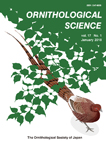Volume 17, Issue 1
Displaying 1-14 of 14 articles from this issue
- |<
- <
- 1
- >
- >|
EDITORIAL
-
2018Volume 17Issue 1 Pages 1
Published: 2018
Released on J-STAGE: April 04, 2018
Download PDF (196K)
ORIGINAL ARTICLE
-
2018Volume 17Issue 1 Pages 3-9
Published: 2018
Released on J-STAGE: April 04, 2018
Download PDF (365K) -
2018Volume 17Issue 1 Pages 11-18
Published: 2018
Released on J-STAGE: April 04, 2018
Download PDF (786K) -
2018Volume 17Issue 1 Pages 19-35
Published: 2018
Released on J-STAGE: April 04, 2018
Download PDF (606K) -
2018Volume 17Issue 1 Pages 37-44
Published: 2018
Released on J-STAGE: April 04, 2018
Download PDF (713K) -
2018Volume 17Issue 1 Pages 45-54
Published: 2018
Released on J-STAGE: April 04, 2018
Download PDF (659K) -
2018Volume 17Issue 1 Pages 55-67
Published: 2018
Released on J-STAGE: April 04, 2018
Download PDF (733K)
REVIEWS
-
2018Volume 17Issue 1 Pages 69-78
Published: 2018
Released on J-STAGE: April 04, 2018
Download PDF (434K)
SHORT COMMUNICATION
-
2018Volume 17Issue 1 Pages 79-85
Published: 2018
Released on J-STAGE: April 04, 2018
Download PDF (424K) -
2018Volume 17Issue 1 Pages 87-93
Published: 2018
Released on J-STAGE: April 04, 2018
Download PDF (1019K) -
2018Volume 17Issue 1 Pages 95-101
Published: 2018
Released on J-STAGE: April 04, 2018
Download PDF (456K) -
2018Volume 17Issue 1 Pages 103-108
Published: 2018
Released on J-STAGE: April 04, 2018
Download PDF (606K) -
2018Volume 17Issue 1 Pages 109-112
Published: 2018
Released on J-STAGE: April 04, 2018
Download PDF (612K) -
2018Volume 17Issue 1 Pages 113-118
Published: 2018
Released on J-STAGE: April 04, 2018
Download PDF (376K)
- |<
- <
- 1
- >
- >|
